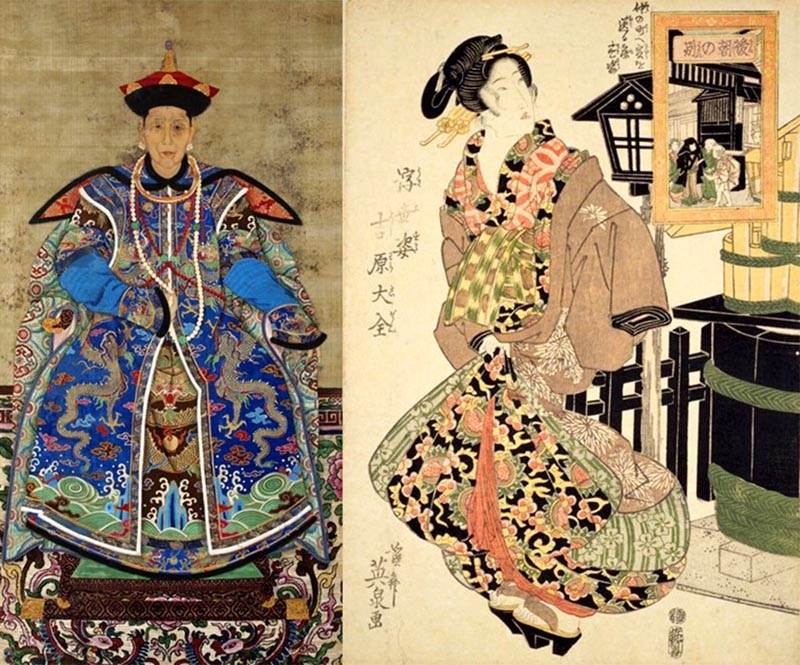East Asian textiles and clothing in motion: Ideas and identities across media and space in the long 19th century
This workshop explores the traces of multiple identities embodied in East Asian textiles and clothing in the long 19th century. In particular, it aims to bring into dialogue different perspectives, material culture studies, art history, and cultural anthropology, to foster thought-provoking reflections on the ways in which textile design shaped meanings and identities.
This workshop takes place at the Leiden University Law Faculty, Kamerlingh Onnes Gebouw (KOG), room B0.25, Steenschuur 2, Leiden.
Registration is required. All are welcome to attend!
The Workshop
This workshop explores the traces of multiple identities embodied in East Asian textiles and clothing in the long 19th century. In particular, it aims to bring into dialogue different perspectives, material culture studies, art history, and cultural anthropology, to foster thought-provoking reflections on the ways in which textile design shaped meanings and identities.
By reflecting in particular on the concepts of diffusion and transfer, the workshop explores how the flexibility, or ‘promiscuity’, of the textile medium allows—historically as well as today—the multidirectional circulation of ideas and aesthetics across different media, and geographical and cultural entities.
How are meanings and identities negotiated once motifs, technologies, and ideas of dress are transferred/diffused/translated across cultural spaces? How are identities constructed when textiles are transferred to pictures? When textiles become clothes? These are just some of the questions that we hope to explore throughout this interdisciplinary workshop.
Programme
14.00- 14.10 – Welcome and introduction
14.10- 14.55 – Dr Lucie Olivová:
Historic Clothing: How Reliable are its Depictions in Ancestor Portraits
- Chinese clothing in museum collections is typically represented by an incomplete set of a formal dress, consisting of one item and without accessories. It is therefore necessary to turn to other sources in order to understand how the dress looked. Although ancestor portraits seem to be an ideal comparative source for this kind of research, they do not reveal all about the formal dress either. This lecture will point out the obstacles which hinder a full interpretation of historic clothing depicted in portraits, and the limits of such a depiction.
14.55-15.15 – Discussion and Q&A
15.15- 15.40 – Coffee break
15.40-16.25 – Dr Keiko Suzuki
Printed Textiles on the Move: A Case Study of Chintz, Batik, Wa-sarasa, and “African Prints”
- This paper will examine diffusion of chintz, which started from India in the early modern time. Tracing the diffusion with its focus on the 19th century demonstrates that, inspired by the imported chintz, various regions tried to produce chintz-like printed textiles by developing not only distinctive technology with textiles, tools, and dyes locally available but also designs that appealed to the locals. While the paper discusses batik in Java, wa-sarasa (chintz made in Japan) printed with katagami stencils, and “African Prints” as such examples, it also reveals that these productions in respective regions have come to entangle to each other over the last two centuries. That is, some katagami came to be design inspirations for “African prints” in Vlisco, whose designs had originally derived from batik. With this research, I strongly advocate research of multiple sites which certainly demonstrates textile designs’ potentials, lasting influence, and entanglement on a global scale.
16.25-16.45 – Discussion & Q&A
16.45-17.00 – Concluding remarks and coffee
The Speakers
Dr Lucie Olivová
Lucie Olivová (PhD), retired, formerly Associate Professor at the Department of Chinese Studies, Masaryk University, Czechia, specializes in Qing dynasty arts and literature. She recently completed a project on the interpretation of clothing in historic visual sources. Her current research focuses on Chinese fashion and Chinoiseries in 18th century Bohemia.
Dr Keiko Suzuki
Keiko Suzuki received her Ph.D. in Anthropology from the University of Wisconsin-Madison, USA. Currently teaching part-time, she is former Professor, Kinugasa Research Organization; and Deputy-director, Art Research Center, Ritsumeikan University, Kyoto, Japan. Her research aims at investigating international (mis)understanding that appears in visual and material culture. Her most recent publication includes: “Border-crossings Seen in Machine Printing and Designs,” in Kimono and Designs: 150 years of Producers and Sellers, pp.125-149, 2020 (in Japanese).
Sponsors
We would like to thank Leiden University’s ‘Chinese Art and Material Culture’ funding; the Isaac Alfred Ailion Foundation; and the Chair of Asian Art for providing the funding for this event.
Registration (required)
Registration is required as seating is limited. Please use the web form on this page to register.
All are welcome to attend!
Please note that we will maintain a waiting list once the maximum number of participants has been reached. If you are put on the waiting list, we will inform you by e-mail. We will also inform you by e-mail if a place becomes available.

Left: Ancestral Portrait of Xu Weiran´s wife (detail), ink and colours on silk, 300 x 115 cm, Náprstek Museum, Prague, No. 19752
Right: Keisai Eisen, Appearances of the Floating World: Yoshiwara Encyclopedia: A Courtesan in Nightclothes Sending a Customer off to Nakanocho, Collection of National Diet Library, Japan. https://dl.ndl.go.jp/pid/1308417